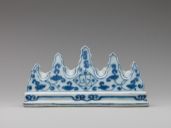Up in the mountains
We landed on the peak of the highest mountain, because that is what the peaks of this brush rest represent. The central peak is the highest, with the outer peaks being lower at each remove. As they taper from the highest mountain peak, the peaks are contoured in an irregular pattern, imitating nature. There is a practical function to this design as well. The jagged contour allows for brushes with different-sized handles to be placed as needed.
These five peaks represent the Five Great Mountains of China Wuyue 五嶽
Both faces of the brush holder are matched in shape, form, and size. They are decorated with a cobalt blue depiction of what appears to be lingzhi 靈芝 fungus with their connotations of long life or immortality in an arabesque manner.
The mountains, flat on the front, sit on a base that extends out a few millimeters and rises, with a slight indentation from the bottom of the brush holder. A single narrow line delineates the flat areas of the mountains that offer a front to the object from the curved, more sculptural flow of the peaks as they flow around to meet their opposite on the other side.
A single blue line extends entirely around the brush holder along the base, while a slightly more ornate line with rolls also extends around the indentation underneath the peaks.
Both sides of the object are flat, but the spaces between — the valleys, if you will — slope up as if to represent the high points of a mountain pass.
The dividers are reminiscent of the traditional mountain scenes depicting rivers flowing between towering precipices as seen in Shan Shui. This combination of the reaching masculine mountains rising heavenward is often contrasted with the more feminine passive flow of water along with the earth.

